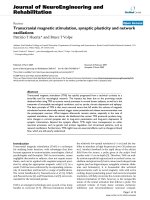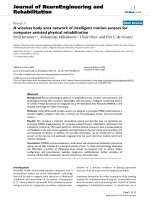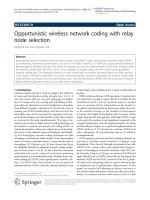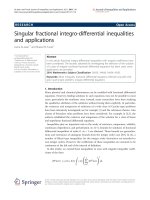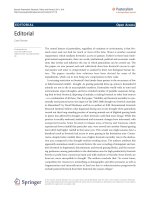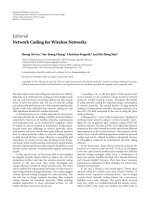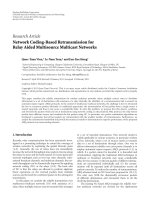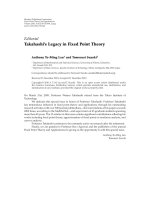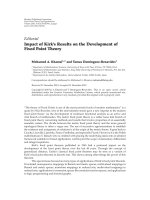Báo cáo hóa học: " Editorial Wireless Network Algorithms, Systems, and Applications" pdf
Bạn đang xem bản rút gọn của tài liệu. Xem và tải ngay bản đầy đủ của tài liệu tại đây (423.27 KB, 2 trang )
Hindawi Publishing Corporation
EURASIP Journal on Wireless Communications and Networking
Volume 2010, Article ID 589389, 2 pages
doi:10.1155/2010/589389
Editorial
Wireless Network Algorithms, Systems, and Applications
Benyuan Liu,
1
Azer Bestavros,
2
Jie Wang,
1
and Ding-Zhu Du
3
1
Department of Computer Science, University of Massachusetts Lowell, Lowell, MA 01854, USA
2
Department of Computer Science, Boston University, MA 02215, USA
3
Department of Computer Science, University of Texas at Dallas, TX 75083, USA
Correspondence should be addressed to Benyuan Liu,
Received 3 February 2010; Accepted 3 February 2010
Copyright © 2010 Benyuan Liu et al. This is an open access article distributed under the Creative Commons Attribution License,
which permits unrestricted use, distribution, and reproduction in any medium, provided the original work is properly cited.
Advances in wireless communication and networking tech-
nologies proliferate ubiquitous infrastructure and ad hoc
wireless networks, enabling a wide variety of applications
ranging from environment monitoring to health care, from
critical infrastructure protection to wireless security, to
name just a few. The complexity and ramifications of
the fast-growing number of mobile users and the variety
of services intensify the interest in developing principles,
algorithms, design methodologies, and systematic evaluation
frameworks for the next-generation wireless networks.
This special issue contains twelve papers selected from
submissions through open calls and the technical program
of the Fourth Annual International Conference on Wireless
Algorithms, Systems, and Applications (WASA 2009), held
in Boston, Massachusetts, USA, during August 16–18, 2009.
These papers highlight some of the current research interests
and achievements in the area of wireless communication
and networking. The topics include routing, localization,
scheduling, target detection and coverage, and privacy in
mobile ad hoc networks and sensor networks.
F. Li, S. Chen, and Y. Wang’s paper presents Circular
Sailing Routing (CSR), a routing protocol that provides a
load-balanced routing for wireless networks. Their method
maps the network onto a sphere via stereographic projection
and makes routing decision by “circular distance” on the
sphere. They show that the distance traveled by packets in
CSR is bounded above by a small constant factor of the length
of the shortest path.
J. Choi, B Y. Choi, S. Song, and K H. Lee’s paper
presents a network quality-aware routing (NQAR) mech-
anism to avoid noisy paths w ith high possibility of colli-
sion, and thus save time from transmission backoffsand
retransmissions. Their experiment results show that NQAR
effectively reduces the end-to-end delay and outperforms
the direct diffusion mechanisms under error-prone environ-
ments.
T. Le and Y. Liu’s paper studies the capacity of hybrid
wireless networks with opportunistic routing. They present
a linear programming method to calculate the end-to-
end throughput in a hybrid network. They show that
opportunistic routing can efficiently utilize base stations and
achieve significantly higher capacity than traditional unicast
routing.
C. Laurendeau and M. Barbeau’s paper presents position-
ing algorithms to estimate the position of an uncooperative
transmitter, based on the received signal strength of a single
target message at a set of receivers with known coordinates.
Their simulation results demonstrate that their algorithms
can effectively localize a target within the regulations stipu-
lated for emergence services location accuracy.
P. D. Tinh and M. Kawai’s paper presents a distributed
range-free algorithm based on self-organizing maps. Their
algorithm uses only connectivity information to determine
node locations. Utilizing the intersection areas between radio
coverages of neighboring nodes, the algorithm intends to
maximize the correlation between the neighboring nodes,
which reduces the learning time significantly.
A. Cakiroglu and C. Erten’s paper provides fully decen-
tralized but collaborative primitives for uniquely localizing
wireless nodes with low computation and messaging require-
ments. The primitives are based on construction of a special
order for multilaterating the nodes within a cluster. With
relatively small clusters and iteration counts, the proposed
approach can localize almost all the nodes that are uniquely
localizable.
2 EURASIP Journal on Wireless Communications and Networking
H.Chen,W.Lou,X.Sun,andZ.Wang’spaperinves-
tigates the impact of wormhole attacks on localization and
presents a consistency-based secure localization scheme. The
localization scheme includes wormhole attack detection,
valid locator identification, and self-localization. The paper
also presents theoretical models to analyze the proposed
localization scheme and evaluate its performance via simu-
lation.
L. Bao and S. Liao’s paper addresses the spectrum scarcity
problem caused by the unbalanced utilization of radio
frequency bands in the current state of w ireless spectrum
allocations. The paper presents a spectrum-access scheduling
to improve the spectrum utilization efficiency in hetero-
geneous wireless systems. Their simulation results show
that spectrum-access scheduling is a feasible and promising
approach to handling the spectrum scarcity problem.
J. Zhou, J. Li, and L. B. Burge III’s paper introduces
the notion of “pigeon networks,” motivated by an ancient
practice of employing pigeons for long-distance communi-
cations, as a special type of delay-tolerant networks (DTNs)
that use special-purpose message carriers for applications
such as disaster recovery. The paper presents efficient
scheduling strategies for message carriers and analyzes the
traffic that can be supported under deadline constraints.
Q. Liang’s paper studies target recognition in radar sen-
sor networks. Inspired by human’s innate ability to process
and integrate information from disparate and network-
based sources, the paper proposes two human-inspired
target detection algorithms for target-detection in radar-
based sensor networks. Simulation results show that the
proposed approaches perform well, whereas the existing two-
dimensional construction algorithm does not work.
G. Fusco and H. Gupta’s paper studies the k-coverage
problem of wireless sensor networks. The goal is to activate
minimum number of sensors to ensure that each target in
the area is covered by at least k sensors. This problem is
NP complete. The authors present an algorithm with an
approximation ratio of O(log M) based on the extension
of the classical ε-net technique, where M is the number of
sensors in an optimal solution.
J. Ren, Y. Li, and T. Li’s paper deals with the source
privacy problem in mobile ad hoc networks (MANETs).
Source privacy is a critical security requirement for mission-
critical applications, especially for MANETs due to node
mobility and the lack of physical protection. The paper
presents communication protocols that provide source pri-
vacy, end-to-end routing privacy, and message authenticity.
The theoretical analysis and simulation show that the
proposed schemes are efficient and can provide a high
message delivery ratio.
Acknowledgments
We thank the authors for contributing papers to the special
issue. We are grateful to members of the program committee
and external referees of WASA 2009 for their work within
demanding time constraints. Finally, we would like to
thank the editorial staff of EURASIP Journal on Wireless
Communications and Networks for their support in editing
this special issue.
Benyuan Liu
Azer Bestavros
Jie Wang
Ding-Zhu Du
